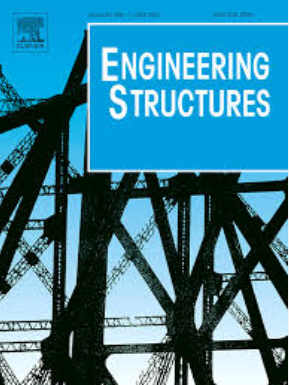Finite element modelling of concrete-filled double-skin steel stiffened tubular chord-to-SHS steel brace T-joints: Behaviour and design
IF 5.6
1区 工程技术
Q1 ENGINEERING, CIVIL
引用次数: 0
Abstract
Although concrete-filled double-skin stiffened steel tubular (CFDSST) members have been researched and applied in recent years, their use in truss T-joints has been lacking. This paper therefore examines the mechanical behaviour of CFDSST chord-to-hollow steel section (SHS) brace T-joints under axial brace loading. Detailed finite element models for CFDSST-to-SHS T-joints are firstly validated by assessing the modelling approaches against recent tests for CFDSST columns and other types of T-joints. The models are subsequently used to conduct parametric assessments into the influence of key factors, including the brace-to-chord width ratio, brace-to-chord thickness ratio, material strengths, hollow ratio of CFDSST chord, and the axial load applied on the chord. It is shown that the ultimate load capacity of the T-joints increases with the increase in the brace-to-chord width ratio as well as with higher steel tube and sandwiched concrete material strength, with a much less pronounced influence from the brace-to-chord thickness ratio. A new parameter representing the flexural stiffness-to-member length ratio of the chord to the brace is also introduced, based on which the failure modes are separated into two categories related to either the failure of the brace or of the chord. Using the detailed results and observations, existing methods for determining the bearing capacities of T-joints are evaluated, leading to the development of a new design approach. The proposed design procedure is shown to provide accurate predictions for CFDSST-to-SHS T-joints, indicating its suitability for use in practical application.
求助全文
约1分钟内获得全文
求助全文
来源期刊

Engineering Structures
工程技术-工程:土木
CiteScore
10.20
自引率
14.50%
发文量
1385
审稿时长
67 days
期刊介绍:
Engineering Structures provides a forum for a broad blend of scientific and technical papers to reflect the evolving needs of the structural engineering and structural mechanics communities. Particularly welcome are contributions dealing with applications of structural engineering and mechanics principles in all areas of technology. The journal aspires to a broad and integrated coverage of the effects of dynamic loadings and of the modelling techniques whereby the structural response to these loadings may be computed.
The scope of Engineering Structures encompasses, but is not restricted to, the following areas: infrastructure engineering; earthquake engineering; structure-fluid-soil interaction; wind engineering; fire engineering; blast engineering; structural reliability/stability; life assessment/integrity; structural health monitoring; multi-hazard engineering; structural dynamics; optimization; expert systems; experimental modelling; performance-based design; multiscale analysis; value engineering.
Topics of interest include: tall buildings; innovative structures; environmentally responsive structures; bridges; stadiums; commercial and public buildings; transmission towers; television and telecommunication masts; foldable structures; cooling towers; plates and shells; suspension structures; protective structures; smart structures; nuclear reactors; dams; pressure vessels; pipelines; tunnels.
Engineering Structures also publishes review articles, short communications and discussions, book reviews, and a diary on international events related to any aspect of structural engineering.
 求助内容:
求助内容: 应助结果提醒方式:
应助结果提醒方式:


